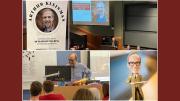The John D. and Catherine T. MacArthur Foundation conferred its $500,000, no-strings-attached fellowships (popularly known as “genius grants”) today. The 22 recipients included faculty members Roland Fryer Jr. (an economist whose Education Innovation Laboratory is covered here); Markus Greiner (a physicist); and Matthew Nock (a psychologist whose studies of suicide and self-injury were featured in this recent Harvard Magazine profile). Alumnae who were recognized include Jeanne Gang, M.Arch. ’93, and Tiya Miles ’92.
Fryer, the Beren professor of economics, was recognized for “offering new insight into such issues as racial discrimination, labor market inequalities, and educational underachievement and illuminating the causes and consequences of economic disparity in American society.”
Greiner, associate professor of physics, was cited for “improving our capacity to control the spatial organization of ultra-cold atoms and applying these advances to both fundamental inquiry and technology.”
Nock, professor of psychology, was singled out for “deepening understanding of self-injury and suicide among adolescents and adults by combining epidemiology, laboratory experiments, and real-time psychological assessments in the interest of saving lives and influencing mental health care in our society.”
Gang, principal and founder of Studio Gang Architects, in Chicago, was honored for architectural designs “integrating conventional materials, striking yet functional designs, and ecologically friendly technology in bold structures that challenge the aesthetic and technical possibilities of the art form.” She has been a visiting professor at the Graduate School of Design. The New York Times subsequently interviewed Gang; the text is accompanied by photographs of several of her award-winning commissions. Paul Goldberger of the New Yorker raved about her Aqua tower in this 2010 assessment, commenting:
A lot of attention—in Chicago, at least—has been given to the fact that Aqua is the tallest building in the world designed by a woman. That’s nice for Gang, but beside the point, and dwelling on it leads too easily to predictable interpretations of skyscrapers as symbols of male identity. Gang’s achievement has more to do with freeing us from such silliness. Her building is most compelling as an example of architecture that is practical and affordable enough to please real-estate developers and stirring enough to please critics. Not many buildings like that get made at any height, or by architects of either gender.
Furthermore, the success of Aqua isn’t just that Gang figured out a smart, low-budget way of turning an ordinary glass condo tower into something that looks exciting. The design is anchored in common sense in two ways that aren’t immediately apparent, making the building, from a technical point of view, even more remarkable than it looks. The balcony overhangs of the façade serve an environmental purpose, shading apartments from the hot summer sun. More ingenious still, they protect the building from the force of wind, one of the most difficult challenges in skyscraper engineering. The landscape of rolling hills and valleys created by the balconies effectively confuses the heavy Chicago winds, giving them no clear path. The wind is broken up so much that the building didn’t require a device known as a “tuned mass damper”—a mass weighing hundreds of tons that engineers place at the top of tall buildings to stabilize them against the vibrations and sway caused by the force of wind. And using the curves to dissipate the wind gave Gang a bonus: she was able to put balconies on every floor, all the way up. Usually, condominiums sixty or seventy floors above the street don’t have balconies, because it’s just too windy up there to go outside.
Miles, an historian at the University of Michigan, was recognized for “reframing and reinterpreting the history of our diverse nation in works that illuminate the complex interrelationships between African and Cherokee peoples in colonial America.”








